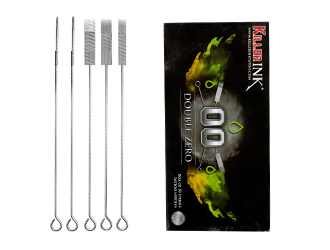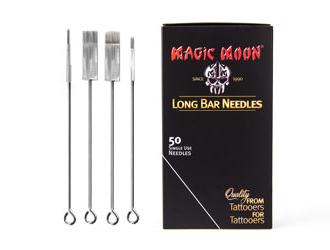Neulat
Suodin
-
20% OFF WITH KILLER20
 From 12,36 € 10,30 €
From 12,36 € 10,30 € -
20% OFF WITH KILLER20
 From 36,00 € 30,00 €
From 36,00 € 30,00 € -
20% OFF WITH KILLER20
 From 32,40 € 27,00 €
From 32,40 € 27,00 € -
20% OFF WITH KILLER20
 From 14,76 € 12,30 €
From 14,76 € 12,30 € -
20% OFF WITH KILLER20
 From 14,76 € 12,30 €
From 14,76 € 12,30 €
Neulat FAQ's
Tattoo Needle Depth for Lining
In order to aim for the dermis, the needle should be sticking out of the end of the tip between 1 and 2 mm - we call this the tattoo needle depth. At the start of your tattoo career, it's best to have the needle out at precisely this length and measure with a ruler, as this prevents you from accidentally going too deep and hitting the hypodermis. Over time, you'll be able to judge the distance by eye.
There's no real difference between needle depth for lining and shading!
How Many Needles Are in a Tattoo Machine?
A tattoo machine doesn't have any needles - the needles are one-use, disposable, and added onto the machine!
If we're talking about needle groupings, they can come in a huge variety and configurations! The description of the needle will tell you how many individual pins are soldered together to create what we call the tattoo needle.
A tattoo needle can have as few as 1 and as many as 49 pins, as seen in our large shader configuration.
How to Put Ink on a Tattoo Needle?
Take your bottle of tattoo ink and pour it into individual ink caps for use during sessions - this ensures that you're never dipping the contaminated needles back into a bottle that will be used for other clients. Always throw away your unused ink!
While your tattoo machine is running, dip the tip into the ink cap and allow the motion of the machine to draw the ink up and into the reservoir - be careful not to hit the sides or bottom of the cap. You can do this without the machine running but you may end up with more excess tattoo ink in the reservoir as the movement of the needle isn't pushing it out. So it's best to have your machine running while dipping.
How to Clean Tattoo Needles Between Colours
When setting up your workstation before tattooing, you should place a small cup of water on the side. When you're changing ink colours, just dip your needles into the cup and let your machine run for a few seconds.
Take the tattoo needles out of the cup and stop your machine so that you can wipe off any excess moisture with a piece of paper towel. It's important to have dry needles before dipping into your next ink colour, or you could potentially dilute or tint the ink. Be careful not to get any lint from the paper towel in your tip or on your needles!
What Size Needle for a Traditional Tattoo?
Traditional American tattoos are defined by bold, black outlines, minimal shading, and highly saturated and packed colours. This eliminates the need for a few types of tattoo needles, but relies heavily on large configurations of liners, such as a 14 round liner.
For the richly saturated colour, use the largest magnum configuration that will fit within the lines - you'll find most traditional tattoo artists still tend to stick with flat magnums, rather than newer configurations like curved magnums.
What Gauge Are Tattoo Needles?
Most tattoo needles have one of the following three gauges: #08 (Bugpin), #10 (Double Zero) and #12 (Standard). The diameter of the needle is sometimes presented in mm, and sometimes in gauges. For example, an #08 gauge needle is 0.25 mm, while a #10 gauge measures 0.30 mm and #12 gauge is 0.35 mm.
What Needle to Use for Colouring a Tattoo?
Flats and magnums are the most popular configurations for colour filling/packing - ideally you'd use a needle grouping as large as possible to fill the area quicker and in one pass. Curved or soft-edge magnums can be used to create depth of colour, while flats are perfect for shading inside geometric designs. Stacked magnums require fewer passes over the skin, making them more comfortable for your client and potentially easier to get the right level of saturation.
For smaller areas, you can just use a round shader and, on occasion, even use a round liner for details in coloured pieces or highlights!
What Needle to Use for Tattoo Outline?
Round liners are the most popular outlining needles, although the thickness of the tattoo outline you want to create will be affected by the number of pins in the grouping, as well as how close together they are. #12 gauge (0.35 mm) round liners are the standard across the board, making for a solid line with fast ink flow.
Some tattoo artists recommend smaller flat or magnum configurations for creating thick lines. Round shaders can also be used for linework if you want the outline to be a bit less solid - not every piece needs the bold outline of a traditional tattoo!
What Are Round Liner Tattoo Needles Used For?
Round liner tattoo needles are generally used for lining purposes. For example, #12 gauge round liners are the standard for creating bold outlines like those seen in the American traditional tattoo style.
Smaller configurations are also useful for fine line tattoo work. This work is super detailed and often results in small but highly detailed tattoos.
Be aware that round liners are often not designed to hold huge amounts of ink, so shading with one could become a slow process!
What Are Textured Tattoo Needles Used For?
A textured tattoo needle is a great choice for artists who want their needles to hold more ink. Unlike standard polished needles, textured needles haven't been polished on the tapers, leading to a larger surface area which is perfect for holding onto ink.
What Is the Difference Between Bugpin and Standard Tattoo Needles?
Bugpin needles are some of the smallest diameter tattoo needles we offer, with the #08 gauge pins having diameters of just 0.25 mm. The narrow diameter allows you to perform precise linework and shading or can be used to create the impression of pixels or small dots when creating dotwork. Fine line artists also tend to use bugpins.
The difference between a bugpin and standard tattoo needle simply comes down to size, with the #12 gauge, or 0.35 mm diameter, needles being what most artists refer to as "standard".
How To Properly Dispose of Tattoo Needles
Tattoo needles are hazardous waste, and need to be treated appropriately, so make sure you have the correct bin! All needles should be disposed of in a yellow sharps bin - this is the same across tattoo studios, PMU clinics, and even hospitals.

















